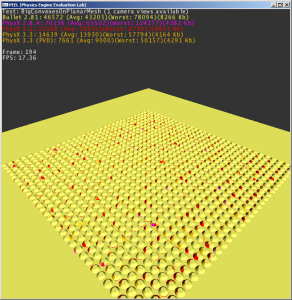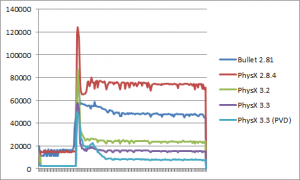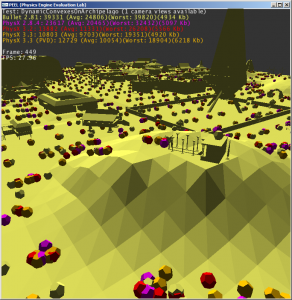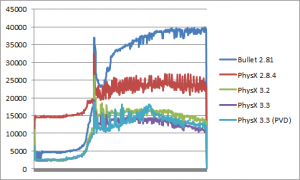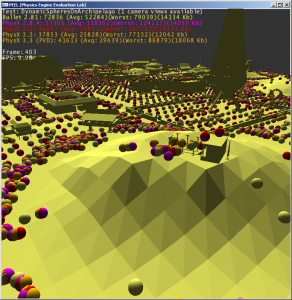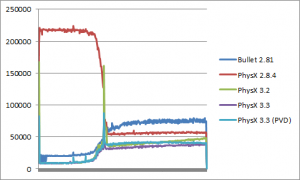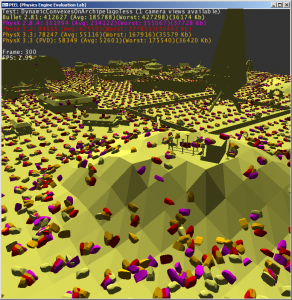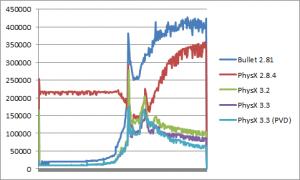The evolution of PhysX (6/12) - Rigid bodies (meshes)
We only used simple shapes so far, but what really makes or breaks an engine is triangle meshes. Supporting meshes is a lot more difficult than supporting other shapes – there’s a full new “midphase” pass that did not exist before, contact generation becomes much harder, meshes use up quite a bit of extra memory, etc.
So let’s see!
—-
The first scene (“BigConvexesOnPlanarMesh”) just drops a lot of big convexes on a tessellated planar mesh. Vanilla stuff just to see where we stand.
The curves are quite interesting. The initial flat part is when the convexes are falling towards the mesh, without actually touching anything. Then follows a large spike, when they hit the mesh. Then things settle down and engines recover from the hit.
Let’s start with memory usage to get that out of the way. There are basically two categories: engines using about 4Mb (PhysX 2.8.4, PhysX 3.3) and engines using twice (!) that amount (Bullet, PhysX 3.2). I’m not sure how to explain it, or why it’s either 4 or 8. In any case, minus point for PhysX 3.2 here.
Each PhysX version is faster than the one before: good. However there was clearly something fishy with 2.8.4, which is slower than Bullet in this scene. That did not happen much so far. Gut feeling is that the SAT code from 2.8.4 didn’t handle that large-convex-vs-tessellated-mesh situation very well.
So, as far as PhysX is concerned, 3.2 has an issue with memory usage, 2.8.4 has an issue with performance, I guess the conclusion is clear: switch to 3.3. It’s just better. On average,PhysX 3.3 /PCM is 7X faster than PhysX 2.8.4 and 4.7X faster than Bullet here. That’s quite a lot.
—-
For the next scene (“DynamicConvexesOnArchipelago”) we drop a bunch of simple convexes on a mesh level. Contrary to what we got in the first scene, the mesh level is made of multiple meshes (not just one), of varying shapes, triangle densities, etc. There are 108 meshes and 46476 triangles in total in that scene.
Overall, each PhysX version is faster than the one before: good. PhysX 3.3 is about 2X faster than 2.8.4, but not that much faster than 3.2.
Bullet starts nicely (much better than 2.8.4) but for some reason it collapses when things start to collide (much slower than 2.8.4).
PCM in PhysX doesn’t seem to help here, but it increases memory usage – which is otherwise quite similar for all engines.
—-
The next scene (“DynamicSpheresOnArchipelago”) is a variation on that same theme: we use a simpler shape, but we drop 4X more of them. The mesh level remains the same.
Each PhysX version is faster than the one before: good.
But man, what is going on with 2.8.4?! For some reason it is very slow in the beginning, and only gains speed when the spheres are touching the mesh. I suspect the 2.8.4 broad phase (SAP) did not like this grid of 4K falling objects at all. The PhysX 3.x broaphases in these tests also use a SAP implementation, but it has been completely rewritten since 2.8.4. Not sure if this is why these engines don’t suffer from the same problem.
If we ignore this initial 2.8.4 anomaly, the curves are quite similar. Bullet works better than in the previous scene, but remains slower than PhysX.
As in the previous scene, PCM in PhysX doesn’t help much, but increases memory usage – which is otherwise quite similar for all engines, again.
—-
In the next scene (“DynamicConvexesOnArchipelagoTess”) we mix things up a bit and crank up the numbers: this time we use a huge number of convexes on the same mesh level, but tessellated. That is, the mesh level still has 108 meshes, but it now contains 743616 triangles (the flat shading doesn’t reflect this, don’t let it fool you).
The resulting curves are kind of similar to what we saw before.
Each PhysX version is faster than the one before: good. There’s about a 4X speedup between 2.8.4 and 3.3 - if you are still using 2.x, you should really consider upgrading!
It is interesting that the flat part of the 2.8.4 curve is a bit above 200000 time units in both this test and the previous one. This happens when the same number of objects is falling towards the mesh, and there are no collisions at all at this point. It really does sound like the broadphase is guilty. After impact, objects start moving in random directions, which breaks the objects alignment, and the SAP starts to breathe again. The curve quickly goes back up because of the expensive convex-vs-tessellated-mesh contact generation anyway.
Bullet starts strong, but collapses again after impact. Good broadphase, not so good contact generation.
On the other hand PhysX 3.2 and especially 3.3 perform quite well both in the broadphase and contact gen departments.
